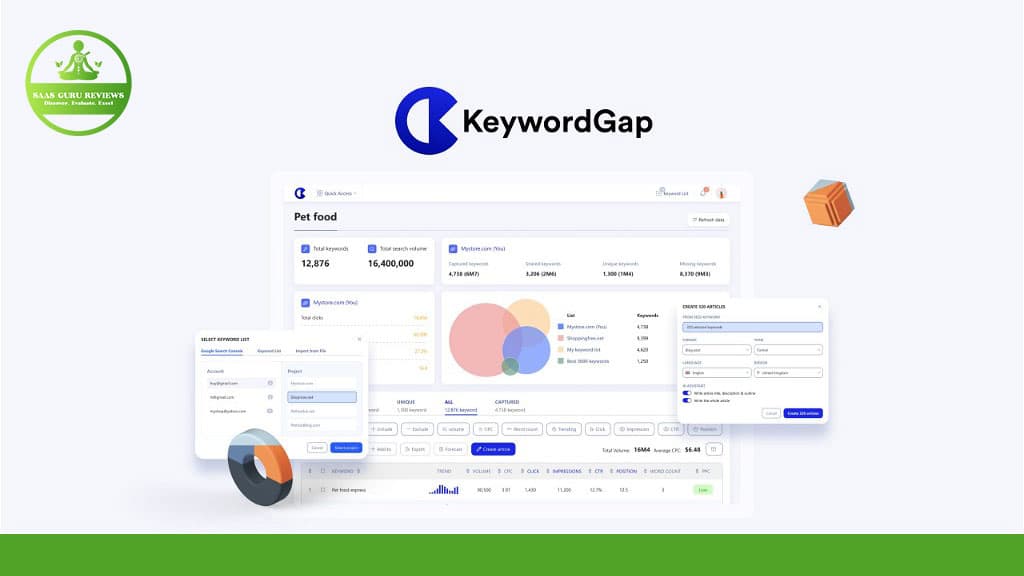In the ever-evolving landscape of search engine optimization (SEO), staying ahead of the competition is paramount. One powerful tool that can provide valuable insights and help you optimize your content strategy is keyword gap analysis. This comprehensive guide will delve into the intricacies of using keyword gap tools to identify profitable keywords your competitors may be overlooking. Whether you’re a seasoned SEO strategist or new to the field, understanding how to analyze and adjust your keyword approach can be a game-changer in achieving SEO success. Read on to uncover hidden keyword opportunities that can propel your website to the top ranks.
Article Outline:
- What is Keyword Gap Analysis?
- Why is Keyword Gap Analysis Critical for SEO Success?
- How to Perform a Keyword Gap Analysis with the Right Tools
- Identifying Your Main Competitors for Effective Comparison
- Analyzing Competitor Keywords: What Are They Ranking For?
- Uncovering Keywords Your Competitors Are Using: A Step-by-Step Guide
- How to Use AI to Enhance Your Keyword Gap Analysis
- Capitalizing on Low Competition Keywords to Dominate Your Niche
- Integrating Keyword Gap Insights into Your Content Strategy
- Adjusting Your SEO Strategy Based on Keyword Gap Findings
- The Role of Search Volume and Keyword Difficulty in Gap Analysis
- Measuring the Impact: How Keyword Gap Analysis Boosts Traffic and Conversion
1. What is Keyword Gap Analysis?
Keyword gap analysis is a strategic method used to uncover the differences between the keywords your website is ranking for and those your competitors are targeting. By identifying these gaps, you can discover new content opportunities and areas where your SEO efforts could be intensified. This process not only helps you to understand your niche better but also enables you to take advantage of untapped markets.
2. Why is Keyword Gap Analysis Critical for SEO Success?
Keyword gap analysis is invaluable for several reasons. It offers a clear view of the competitive landscape, helping you to understand which keywords are driving traffic to your competitors’ sites. By analyzing these gaps, you can refine your SEO strategy to include keywords that resonate with your target audience, ultimately driving more traffic to your site and increasing your online visibility.
3. How to Perform a Keyword Gap Analysis with the Right Tools
To perform a keyword gap analysis, you’ll need to utilize a reliable SEO tool that can compare your domain against competitors’. Tools like KeywordGap provide a comprehensive overview of the keywords you’re ranking for, as well as those your competitors are targeting. By using these insights, you can adjust your content strategy to fill the gaps and enhance your rank on search engines.
4. Identifying Your Main Competitors for Effective Comparison
The first step in keyword gap analysis is to identify who your main competitors are. Look for businesses in your niche that are ranking well for keywords relevant to your industry. Once you’ve compiled a list of competitors, you can start to compare your keyword performance against theirs to identify potential opportunities.
5. Analyzing Competitor Keywords: What Are They Ranking For?
Using a keyword tool, analyze the keywords that your competitors are ranking for. Pay attention to high-volume phrases that are highly relevant to your target audience. These are the keywords that could potentially drive significant traffic to your site if you manage to rank for them.
6. Uncovering Keywords Your Competitors Are Using: A Step-by-Step Guide
To uncover the keywords your competitors are using, follow these steps: select a keyword tool, enter your competitors’ domains, and compare the keyword profiles. Look for keywords that have a high search volume but low competition, as these present the best opportunities for your SEO strategy.
7. How to Use AI to Enhance Your Keyword Gap Analysis
AI-powered keyword tools can streamline the gap analysis process by quickly parsing large data sets and providing actionable insights. These tools can help you identify trends and patterns that human analysis might miss, ensuring that you’re always one step ahead of your competitors.
8. Capitalizing on Low Competition Keywords to Dominate Your Niche
After identifying low competition keywords, it’s time to capitalize on them. Integrate these keywords into your new content or optimize existing content to improve your rankings. By targeting these keywords, you can attract more targeted traffic and potentially dominate your niche.
9. Integrating Keyword Gap Insights into Your Content Strategy
Integrating keyword gap insights into your content strategy is crucial for achieving SEO success. Use the information gathered to create or update content that fills the gaps. This could mean writing new blog posts, updating product descriptions, or creating informative articles that target the newly identified keywords.
10. Adjusting Your SEO Strategy Based on Keyword Gap Findings
Based on your keyword gap findings, adjust your SEO strategy to prioritize the most promising keywords. This might involve shifting your focus from highly competitive keywords to those that offer a better chance of ranking higher and driving more qualified traffic to your site.
11. The Role of Search Volume and Keyword Difficulty in Gap Analysis
When conducting keyword gap analysis, it’s important to consider search volume and keyword difficulty. These metrics will help you determine the potential traffic a keyword could bring and how hard it would be to rank for it. Focus on keywords with a good balance of high search volume and low difficulty for the best results.
12. Measuring the Impact: How Keyword Gap Analysis Boosts Traffic and Conversion
Finally, measure the impact of your keyword gap analysis by tracking changes in traffic and conversion rates. Over time, you should see an increase in rankings for the targeted keywords, which can lead to more website visits and higher conversion rates.
Summary of Key Points:
- Keyword gap analysis is a powerful tool for uncovering hidden keyword opportunities and refining your SEO strategy.
- Identifying and comparing your keywords with those of your competitors can reveal valuable insights.
- Utilize AI-powered tools to enhance the efficiency and accuracy of your analysis.
- Focus on low competition keywords to potentially dominate your niche and drive targeted traffic.
- Integrate keyword gap findings into your content strategy and adjust your SEO tactics accordingly.
- Always consider search volume and keyword difficulty when selecting keywords to target.
- Measure the impact of your keyword gap analysis on traffic and conversion to ensure SEO success.
Keyword gap analysis is an essential component of a successful SEO strategy. By following this guide, you can uncover hidden keyword opportunities, optimize your content, and ultimately increase your online presence and profitability.
In the ever-evolving landscape of search engine optimization (SEO), staying ahead of the competition is paramount. One powerful tool that can provide valuable insights and help you optimize your content strategy is keyword gap analysis. This comprehensive guide will delve into the intricacies of using keyword gap tools to identify profitable keywords your competitors may be overlooking. Whether you’re a seasoned SEO strategist or new to the field, understanding how to analyze and adjust your keyword approach can be a game-changer in achieving SEO success. Read on to uncover hidden keyword opportunities that can propel your website to the top ranks.
Article Outline:
- What is Keyword Gap Analysis?
- Why is Keyword Gap Analysis Critical for SEO Success?
- How to Perform a Keyword Gap Analysis with the Right Tools
- Identifying Your Main Competitors for Effective Comparison
- Analyzing Competitor Keywords: What Are They Ranking For?
- Uncovering Keywords Your Competitors Are Using: A Step-by-Step Guide
- How to Use AI to Enhance Your Keyword Gap Analysis
- Capitalizing on Low Competition Keywords to Dominate Your Niche
- Integrating Keyword Gap Insights into Your Content Strategy
- Adjusting Your SEO Strategy Based on Keyword Gap Findings
- The Role of Search Volume and Keyword Difficulty in Gap Analysis
- Measuring the Impact: How Keyword Gap Analysis Boosts Traffic and Conversion
1. What is Keyword Gap Analysis?
Keyword gap analysis is a strategic method used to uncover the differences between the keywords your website is ranking for and those your competitors are targeting. By identifying these gaps, you can discover new content opportunities and areas where your SEO efforts could be intensified. This process not only helps you to understand your niche better but also enables you to take advantage of untapped markets.
2. Why is Keyword Gap Analysis Critical for SEO Success?
Keyword gap analysis is invaluable for several reasons. It offers a clear view of the competitive landscape, helping you to understand which keywords are driving traffic to your competitors’ sites. By analyzing these gaps, you can refine your SEO strategy to include keywords that resonate with your target audience, ultimately driving more traffic to your site and increasing your online visibility.
3. How to Perform a Keyword Gap Analysis with the Right Tools
To perform a keyword gap analysis, you’ll need to utilize a reliable SEO tool that can compare your domain against competitors’. Tools like KeywordGap provide a comprehensive overview of the keywords you’re ranking for, as well as those your competitors are targeting. By using these insights, you can adjust your content strategy to fill the gaps and enhance your rank on search engines.
4. Identifying Your Main Competitors for Effective Comparison
The first step in keyword gap analysis is to identify who your main competitors are. Look for businesses in your niche that are ranking well for keywords relevant to your industry. Once you’ve compiled a list of competitors, you can start to compare your keyword performance against theirs to identify potential opportunities.
5. Analyzing Competitor Keywords: What Are They Ranking For?
Using a keyword tool, analyze the keywords that your competitors are ranking for. Pay attention to high-volume phrases that are highly relevant to your target audience. These are the keywords that could potentially drive significant traffic to your site if you manage to rank for them.
6. Uncovering Keywords Your Competitors Are Using: A Step-by-Step Guide
To uncover the keywords your competitors are using, follow these steps: select a keyword tool, enter your competitors’ domains, and compare the keyword profiles. Look for keywords that have a high search volume but low competition, as these present the best opportunities for your SEO strategy.
7. How to Use AI to Enhance Your Keyword Gap Analysis
AI-powered keyword tools can streamline the gap analysis process by quickly parsing large data sets and providing actionable insights. These tools can help you identify trends and patterns that human analysis might miss, ensuring that you’re always one step ahead of your competitors.
8. Capitalizing on Low Competition Keywords to Dominate Your Niche
After identifying low competition keywords, it’s time to capitalize on them. Integrate these keywords into your new content or optimize existing content to improve your rankings. By targeting these keywords, you can attract more targeted traffic and potentially dominate your niche.
9. Integrating Keyword Gap Insights into Your Content Strategy
Integrating keyword gap insights into your content strategy is crucial for achieving SEO success. Use the information gathered to create or update content that fills the gaps. This could mean writing new blog posts, updating product descriptions, or creating informative articles that target the newly identified keywords.
10. Adjusting Your SEO Strategy Based on Keyword Gap Findings
Based on your keyword gap findings, adjust your SEO strategy to prioritize the most promising keywords. This might involve shifting your focus from highly competitive keywords to those that offer a better chance of ranking higher and driving more qualified traffic to your site.
11. The Role of Search Volume and Keyword Difficulty in Gap Analysis
When conducting keyword gap analysis, it’s important to consider search volume and keyword difficulty. These metrics will help you determine the potential traffic a keyword could bring and how hard it would be to rank for it. Focus on keywords with a good balance of high search volume and low difficulty for the best results.
12. Measuring the Impact: How Keyword Gap Analysis Boosts Traffic and Conversion
Finally, measure the impact of your keyword gap analysis by tracking changes in traffic and conversion rates. Over time, you should see an increase in rankings for the targeted keywords, which can lead to more website visits and higher conversion rates.
Summary of Key Points:
- Keyword gap analysis is a powerful tool for uncovering hidden keyword opportunities and refining your SEO strategy.
- Identifying and comparing your keywords with those of your competitors can reveal valuable insights.
- Utilize AI-powered tools to enhance the efficiency and accuracy of your analysis.
- Focus on low competition keywords to potentially dominate your niche and drive targeted traffic.
- Integrate keyword gap findings into your content strategy and adjust your SEO tactics accordingly.
- Always consider search volume and keyword difficulty when selecting keywords to target.
- Measure the impact of your keyword gap analysis on traffic and conversion to ensure SEO success.
Keyword gap analysis is an essential component of a successful SEO strategy. By following this guide, you can uncover hidden keyword opportunities, optimize your content, and ultimately increase your online presence and profitability.



